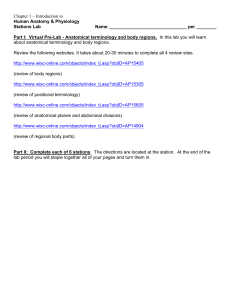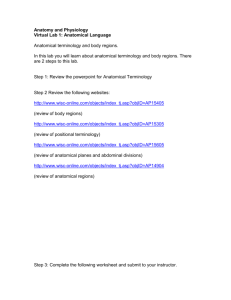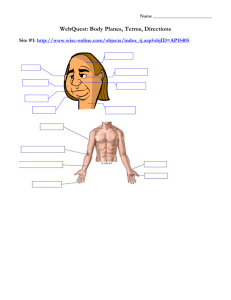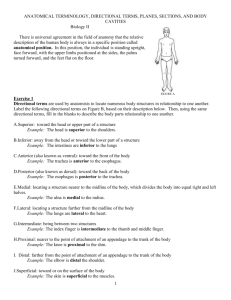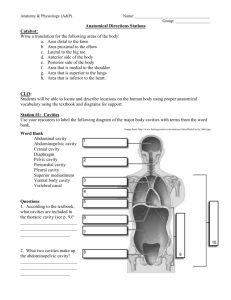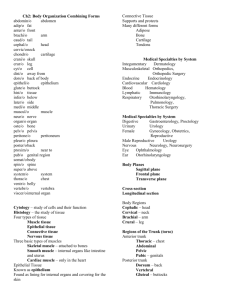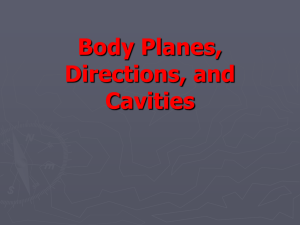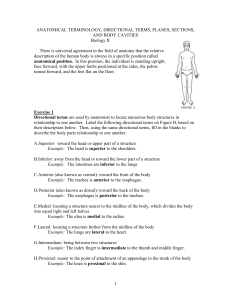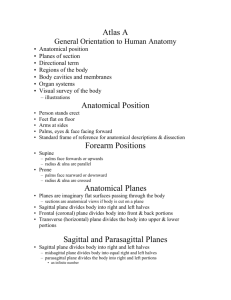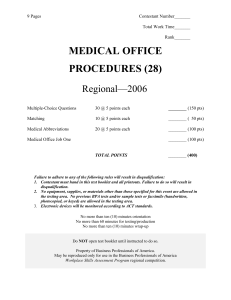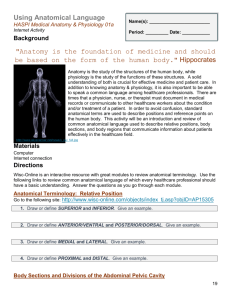Terminology Stations Lab - McCarter Anatomy & Physiology
advertisement
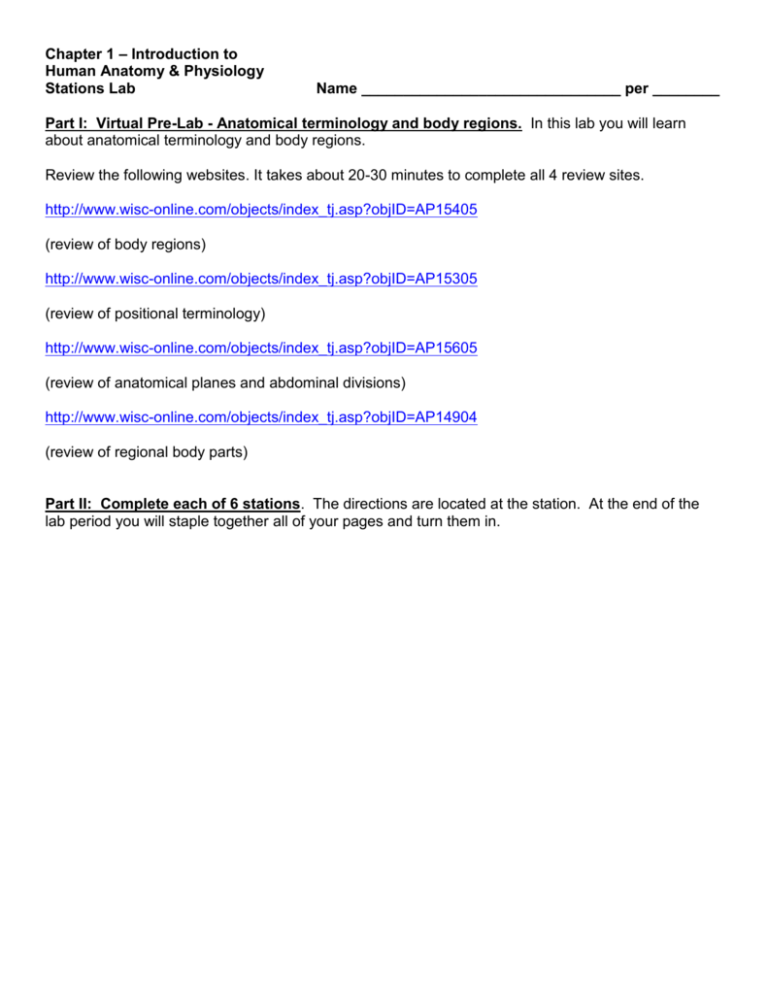
Chapter 1 – Introduction to Human Anatomy & Physiology Stations Lab Name _______________________________ per ________ Part I: Virtual Pre-Lab - Anatomical terminology and body regions. In this lab you will learn about anatomical terminology and body regions. Review the following websites. It takes about 20-30 minutes to complete all 4 review sites. http://www.wisc-online.com/objects/index_tj.asp?objID=AP15405 (review of body regions) http://www.wisc-online.com/objects/index_tj.asp?objID=AP15305 (review of positional terminology) http://www.wisc-online.com/objects/index_tj.asp?objID=AP15605 (review of anatomical planes and abdominal divisions) http://www.wisc-online.com/objects/index_tj.asp?objID=AP14904 (review of regional body parts) Part II: Complete each of 6 stations. The directions are located at the station. At the end of the lab period you will staple together all of your pages and turn them in. Station #1 – Story Time Directions: Working as a group, incorporate the following terms into a short story. You must use at least 20 of the words below. Write the story on this paper or type it on google docs and share it with me. Underline each of the terms in your story. You will turn in only one story for your whole group. Superior Abdominal Cavity Lateral Distal Peristalsis Apendicitis Gluteal Visceral Organs Dorsal Orbital cavity LLQ Gastrointestinal Tract Transverse Section Pharmacology Inferior Pelvic Cavity Proximal LUQ Cerebrum Liver Homeostasis Anterior Medial RUQ RLQ Melanoma Ipsilateral Cells Superficial Deep Hepatitis Integument Tracheotomy Proximal Superficial Name _________________________________ Station #2 – Color Code Directions: Individually 1. Using the diagrams below, color code each section as follows. Right Upper Quadrant = purple Left Upper Quadrant = black Right Lower Quadrant = pink Left Lower Quadrant = light blue Umbilical region = green Lumbar regions = blue Epigastric region = red Iliac regions = orange Hypochondriac regions = yellow Hypogastric region = brown 2. Using the diagrams below color code each cavity as follows. a. Thoracic cavity = pink Vertebral canal = purple b. Pericardial cavity = brown Pleural cavities = orange Cranial cavity = yellow Abdominopelvic cavity = red Pelvic cavity = green Abdominal cavity = blue Cranial cavity = yellow Vertebral Canal = purple 3. ID each of the body systems and function of the system using the laminated cards on your lab table. Card letter = ___System_____ _= major function of system ______________________ A = _____________________________ = _____________________________________________ B = _____________________________= _____________________________________________ C = _____________________________= _____________________________________________ D = _____________________________= _____________________________________________ E = _____________________________= _____________________________________________ F = _____________________________= _____________________________________________ G = _____________________________= _____________________________________________ H = _____________________________= _____________________________________________ I = ______________________________= _____________________________________________ J = ______________________________= _____________________________________________ K = _____________________________= _____________________________________________ Chapter 1 – Introduction to Human Anatomy & Physiology Stations Lab Name _______________________________ per ________ Station #3 – Surgery Directions: Individually Dr. Student, you do not want to be sued for malpractice. Your surgical team requires collaboration and planning. Know what you are going to do before you cut. All surgical incisions are permanent. Scarring is probable. Remember the anesthesiologist has given you only 15 minutes. The Sharpie is your scalpel. Your patient requires multiple procedures. Please perform the following: Appendectomy – deep lateral incision in the anterior RLQ Cesarean section – deep lateral incision in the pelvic cavity 10 cm distal to the belly button Left legectomy (what is the proper term?) – incision distal to the knee joint Carotid endorectomy – vertical superficial to the carotid artery incision 4 cm from the medial plane of the trachea Use the information provided to make the correct surgical incisions to perform the required surgeries. After you complete the surgery, draw on your body diagram where you made the incisions. Station #4 – Mr. (or Mrs.) Potato Head Directions: As a Group The organization of the body and structural relationships among the parts can be described by a consistent system of anatomical terminology. You will be given a large potato and your task will be to label the following list of anatomical terms on your spud. To do this you will use toothpicks and masking tape as a “flag” for each label. You may use the accessories on your lab table to help dress up your spud. When you are finished with your potato, please leave on the back lab counter so that we may judge them. The winner will be the one that is most original in design and most “anthropomorphic” (ie most correct) potato!! LIST: sagittal plane midsagittal plane transverse plane pelvic coronal plane medial posterior thoracic lateral proximal cranial inferior distal anterior abdominal superior ventral dorsal Station #5 – Rewrites Directions: As a group, rewrite each statement using common terminology. The first one is done for you. Work as a group, but each person must write down the new sentence and each person will turn in a worksheet as part of their lab. 1. Pain is located in the right cervical region with radiation into the ipsilateral brachial region. (answer: pain is located in the right neck and radiates into the right upper arm) 2. The lesion is located in the right thorax just lateral to the mid-sagittal plane. 3. The patient reports numbness and tingling in the left lumbar area and pain in the contralateral femoral region. 4. There is a contusion located at the lateral aspect of the left crural region. 5. The laceration extends distally from the right antecubital region to the antebrachium. 6. The patient reports sharp right lower quadrant pain just lateral to the umbilicus. 7. The patient reported a tearing sensation while running in the right gluteal region extending distally to the ipsilateral popliteal region. 8. There was pain located at the right lateral tarsal region with subsequent numbness and tingling in the ipsilateral dorsum of the foot. 9. The patient reported sharp cervical pain extending into the bilateral brachial regions. Station #6 – Jeopardy! Directions: We will design a Jeopardy review game for Chapter 1 as a class. Your group is responsible for developing one category of questions (see below). Use your book and/or the computer to help you design the answers and questions for your assigned category. The template is set up for you on the computer at your lab table. You will be filling in 2 slides per point value question – an “answer” and then a “question”. The 100 point questions should be easier and get progressively more difficult as you go to the 500 point questions. Remember to SAVE after adding each answer and question. I will post this game plus the game designed by my other class on the website under the “Review” tab for chapter 1. Group # Category 1 Organ Systems (pg 14-19) 2 Homeostasis (pg 7-12) 3 Abdominal Regions (pg 24) 4 Body Regions (from pg 25) 5 Planes and Positions (pg 21-23) 6 Anything Goes (from all of chapter 1 – make sure no question is repeated)
